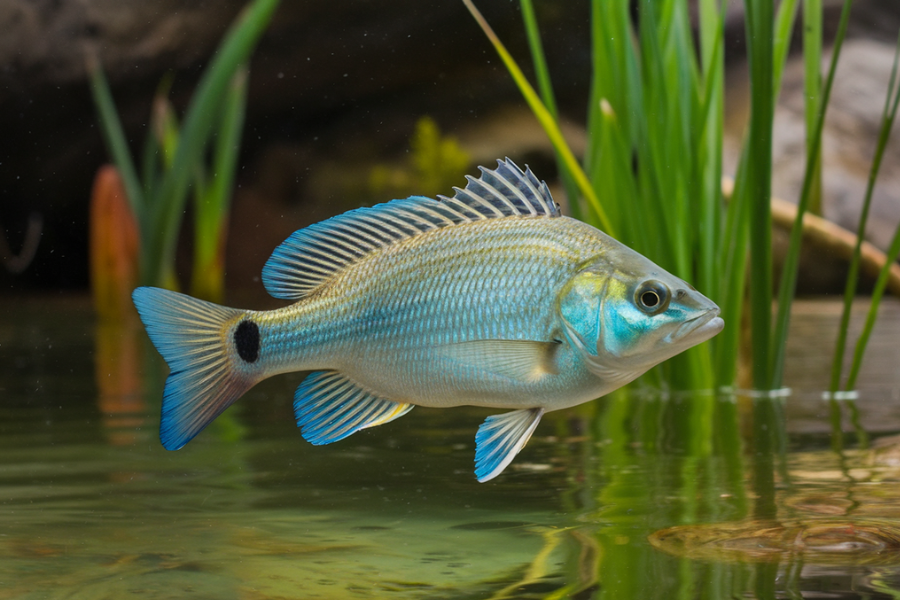Introduction
For pond enthusiasts and those maintaining water habitats, determining the correct number of bluegill for a pond is essential for a balanced aquatic ecosystem. Proper stocking of bluegill not only enhances the aesthetics of a pond but also supports fish health and ensures sustainable pond conditions. This guide explores the essentials of stocking bluegill in a 7,400-gallon pond, helping you establish a healthy environment where your bluegill can thrive.
Getting to Know Bluegill: Basics and Habitat Preferences
Bluegill, or Lepomis macrochirus, is a popular choice for ponds and freshwater habitats. Known for their resilience and adaptability, bluegills thrive in ponds, lakes, and slow-moving streams. Their adaptability makes them relatively easy to care for, but ensuring optimal stocking ratios is still critical to their well-being.
When evaluating how many bluegill to stock in a 7,400-gallon pond, several factors must be considered beyond pond volume alone. Elements like aeration, aquatic vegetation, and other fish species in the habitat play crucial roles in maintaining a stable, supportive environment for the bluegill.
The Importance of Correct Stocking Ratios
An adequately stocked pond can foster healthy fish growth, prevent overcrowding, and reduce the risk of health issues among the fish. Understocking or overstocking a pond can throw off the ecosystem balance. Overstocking results in increased competition for resources, which can cause stress, poor water quality, and disease spread. On the other hand, understocking may not fully support the desired fish population growth.
General Stocking Recommendations for Bluegill
Generally, a safe stocking density for bluegill is 2-3 fish per 100 gallons of water. However, adapting this number to fit the unique needs of your pond and fish population is essential.
- Low Stocking Density (Approximately 150 Bluegill): For a relaxed, natural pond environment with minimal upkeep, about 150 bluegill is recommended. This lower density minimizes the chance of overcrowding, allowing each fish plenty of space to grow while keeping water quality high.
- Moderate Stocking Density (Approximately 175 Bluegill): A moderate density balances the benefits of a well-populated pond with water quality. Stocking around 175 bluegill allows room for population growth while ensuring oxygen levels remain stable and water quality is manageable.
- High Stocking Density (Approximately 220 Bluegill): If you maintain a well-aerated pond with consistent filtration, stocking up to 220 bluegill can work. This approach is ideal for those prepared to invest time in maintenance tasks, such as monitoring water quality and managing vegetation growth. While higher densities require more attention, they support a more active, vibrant pond population.
Factors Impacting Stocking Choices
Beyond water volume, other factors significantly impact the number of bluegill your pond can sustain. Here are some critical considerations:
Aeration and Oxygen Levels:
Bluegill need a well-oxygenated environment to thrive. Oxygen levels decrease as fish populations rise, so adding aerators or fountains can help stabilize oxygen levels, especially during warmer months.
Pond Vegetation:
Aquatic plants play an essential role by providing shade, shelter, and food for fish. In addition, plants contribute oxygen and absorb excess nutrients, helping to maintain water quality. More vegetation can support a larger fish population but should be regularly maintained to prevent overcrowding.
Presence of Other Species:
If you plan to add other species like bass, minnows, or catfish to the pond, you’ll need to adjust the bluegill stocking density to prevent overpopulation and resource depletion. Each species has its unique space and dietary needs, so ensuring balanced cohabitation is essential.
Water Quality and Filtration:
The better the water quality, the more fish a pond can sustain. Good filtration, balanced pH levels, and nutrient control contribute to a healthier pond environment that can support a denser fish population. Regular testing is necessary to keep water within suitable ranges for bluegill.
Feeding Routine:
Bluegill primarily rely on insects, plankton, and small invertebrates in their natural habitats, but many pond owners supplement their diet with fish food. Regular feeding allows for a higher stocking density, but overfeeding can lead to excess nutrients, which can spur algae growth and deplete oxygen.
Tips for Maintaining a Healthy Bluegill Population
Once you’ve decided on the right number of bluegill for your pond, keeping the population healthy and balanced requires regular care and monitoring.
Routine Water Testing:
Regularly check parameters like pH, ammonia, and nitrate levels. Keeping these in an optimal range prevents stress and health issues for the fish.
Adequate Aeration:
Providing additional oxygen through aerators, fountains, or waterfalls helps prevent oxygen depletion and keeps fish active and healthy.
Moderate Feeding:
Feed your bluegill quality fish food in appropriate amounts to avoid nutrient build-up. Overfeeding can lead to poor water quality and harm the overall ecosystem balance.
Manage Aquatic Vegetation:
Plants are crucial for maintaining pond health, but too much vegetation can create problems. Trim plants regularly to balance coverage and open water space, promoting both fish health and water quality.
The Ecological Role of Bluegill in Pond Environments
Bluegills contribute to the ecological balance within a pond. They help control insect populations by feeding on aquatic insects and larvae, reducing the risk of overpopulation and supporting natural algae management. Additionally, bluegills serve as a food source for larger predatory fish, creating a self-sustaining food web within the pond.
Seasonal Adjustments and Population Control
Monitoring fish populations seasonally is essential, as fish behavior and environmental conditions vary with changing weather. For example, bluegill breeding tends to peak in warmer months, potentially increasing the population. Managing population growth through controlled breeding and seasonal checks is vital to maintaining a sustainable bluegill count.
In colder months, fish metabolism slows, and they consume less oxygen, which can ease the demands on aeration systems. However, monitoring water conditions even in cooler weather is still necessary, as winter die-offs can lead to sudden changes in water quality.
Final Considerations: Stocking Bluegill for Long-Term Pond Health
Determining how many bluegill are appropriate for 7,400 gallons of water requires careful planning, ongoing maintenance, and consideration of various factors unique to your pond. A stocking density between 150 and 220 bluegill typically provides a balanced, healthy population, depending on your pond’s specific setup.
Stocking bluegill enriches pond aesthetics and supports a balanced ecosystem that can thrive for years. Whether for recreational fishing or to enjoy a lively pond environment, the correct number of bluegill creates a sustainable and enjoyable aquatic habitat. With proper planning, you can establish a successful bluegill population, contributing to a self-sustaining pond ecosystem.
Conclusion
Creating a healthy bluegill population in a 7,400-gallon pond requires balancing fish numbers with factors like aeration, vegetation, water quality, and other species. By following stocking guidelines and practicing regular maintenance, you can achieve a vibrant and sustainable pond that benefits fish and pond aesthetics alike.
The next time you wonder, “How many bluegills should https://glamourcrunch.com/ I add to my pond?” remember that thoughtful planning and ongoing care will provide a successful, beautiful habitat that brings joy and ecological value to your water feature.











